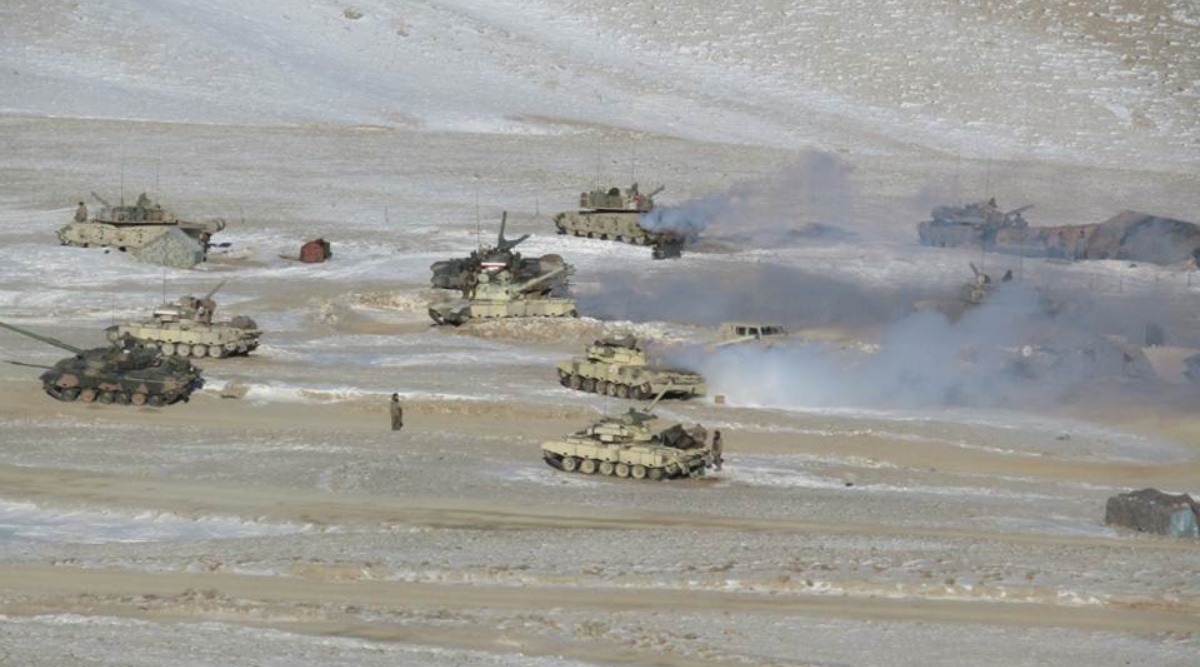NG Missile Vessels
FULL MEMBER

- Joined
- Apr 9, 2023
- Messages
- 1,600
- Reaction score
- 0
- Country
- Location
From temperature-controlled shelters to special fuel and batteries – the Indian Army has taken multiple measures to sustain hundreds of tanks and other mechanised vehicles during the fourth winter of their deployment in eastern Ladakh where the mercury plunges several notches below freezing point, top officials in the government have told The Indian Express.
According to the report of Indian Express, preparations have been intensified to save hundreds of tanks and other mechanized vehicles from the dangerous winter of Ladakh. Since the standoff with China on LAC started in May 2020, the Indian Army has increased its presence in Ladakh. This is going to be the fourth year when a large number of soldiers are going to be present on the border. The Indian Army has deployed more than 400 or about three brigades of Russian-origin T-72 and T-90 tanks and BMPs in eastern Ladakh. Earlier only one third of them were deployed here.
How are the tanks being taken care of?
●To maintain the tanks, the Indian army is using lead tin batteries instead of lead-acid batteries.
The report quoted the official as saying, "These are being used for trucks and are being tested for heavier armoured vehicles. These batteries deliver high current and are vital for starting tanks in extremely low temperatures."
●Special fuels, multigrade lubricants and hydraulic fluids are being used that can withstand the freezing cold.
A common diesel fuel for the entire fleet has successfully gone through trials and will be procured for all vehicles, ranging from trucks, infantry combat vehicles, tanks, and artillery guns, easing the logistics burden.
Moreover, advanced multigrade lubricants that do not freeze or lose viscosity are being introduced for both tanks and artillery guns.
●Repair facilities have been prepared before Leh, where other vehicles including tanks can be repaired in case of medium level faults.
●Heat shelters have been prepared for armored vehicles.
●Continuous operational checks and drills are being conducted so that the capability of the vehicles can be tested.
All these measures, according to the report, have allowed a 95 per cent fleet readiness, enabling quick responses from the Indian army.
The report states, “At the operational and tactical level, introduction of specialist equipment to include rectifiers, PLT batteries, utilisation of specialist grade FOL (fuels, oils, lubricants), preventive maintenance and development of best practices have enabled operational readiness of 95 per cent, which contributes significantly to the operational preparedness of the Indian Army.
Ladakh area suitable for tanks
Officials say that it is a challenge to properly maintain such a large fleet of tanks here. Especially in those areas of eastern Ladakh which are present at very high altitude. The temperature here reaches minus 30 degrees. However, Ladakh's dry desert-like terrain is considered excellent for the deployment of tanks and mechanized vehicles and its river valleys are suitable for manoeuvres. Due to low temperature, fuel and lubricants freeze.
Special shelters built for soldiers
The Indian army is also working hard to protect its soldiers from the harsh winter of Ladakh. Temperature control shelters have been built for the soldiers. Air blowers are installed in these, so that the temperature inside the shelter can be controlled. The entire fleet can be kept in these shelters. 70,000 Indian soldiers have been deployed in eastern Ladakh to deal with every challenge from China. Apart from this, tanks, artillery guns and IFVs have also been deployed.

New shelters, special fuel, batteries: Indian armour gets ready for Ladakh winter
Temperatures dip to minus 30 degree Celsius during winters in eastern Ladakh, freezing fuel and lubricants, and affecting the hydraulics, electronics and batteries of sophisticated weapons
Last edited:



